Key takeaways:
- Participatory budgeting (PB) empowers citizens by allowing them to directly influence the allocation of public funds, fostering democratic engagement and community ownership.
- PB strengthens trust between citizens and local governments, encouraging collaboration and addressing community needs while ensuring diverse voices are heard.
- Challenges include complex budget processes, ensuring diverse representation, and navigating conflicting community priorities that require skilled facilitation.
- The future of PB looks promising with advancements in technology, increased accountability, and innovative outreach strategies aimed at enhancing inclusivity and civic engagement.
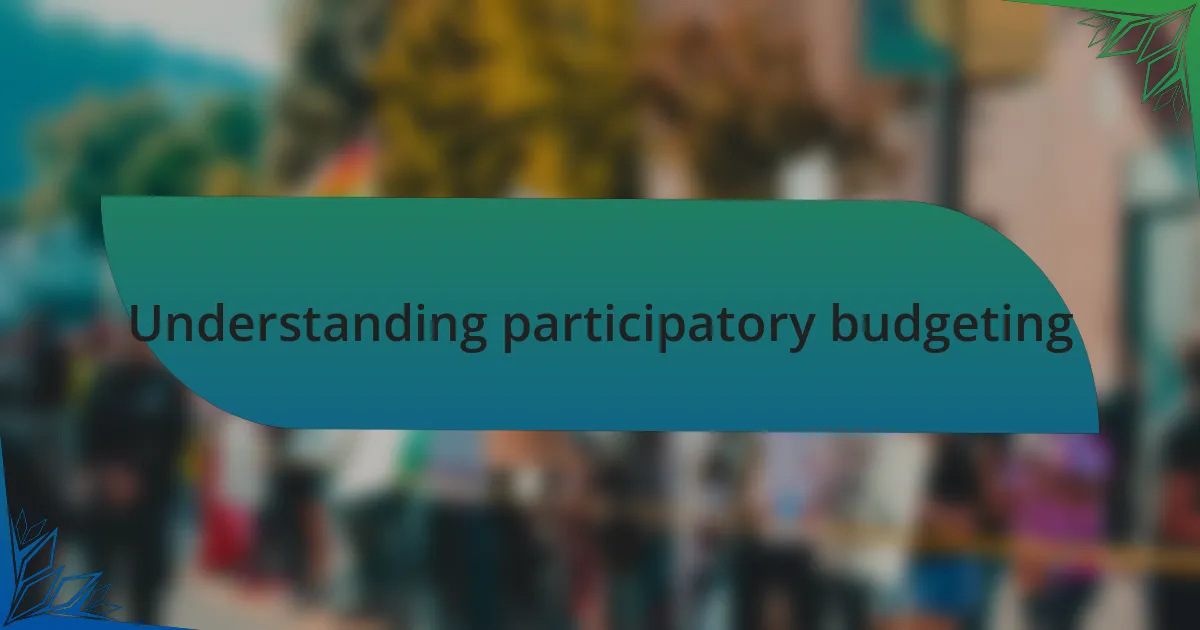
Understanding participatory budgeting
Participatory budgeting (PB) is an empowering process that invites citizens to play a direct role in deciding how to allocate public funds. I recall my initial experience attending a local PB meeting, where the air buzzed with excitement and voices spoke up, passionate about community needs. As I listened to my neighbors share their visions, I realized that PB can transform ordinary people into active, engaged participants in governance.
At its core, participatory budgeting fosters transparency and accountability in public spending. It’s fascinating to think about how many people may not realize that their voices can truly shape local priorities. When I saw the eagerness of individuals presenting their project ideas, it struck me how this process not only enhances democratic engagement but also cultivates a sense of ownership within the community.
Moreover, PB challenges traditional notions of governance by decentralizing power and breaking down the barriers that often prevent marginalized groups from being heard. I remember one participant sharing a personal story about the lack of recreational facilities in her neighborhood and how she feared her children had little to no safe spaces to play. In that moment, the emotional weight of her experience underscored the importance of making budgeting decisions inclusive, and it prompted me to reflect: How often do we consider the diverse voices that go unheard in our own communities?
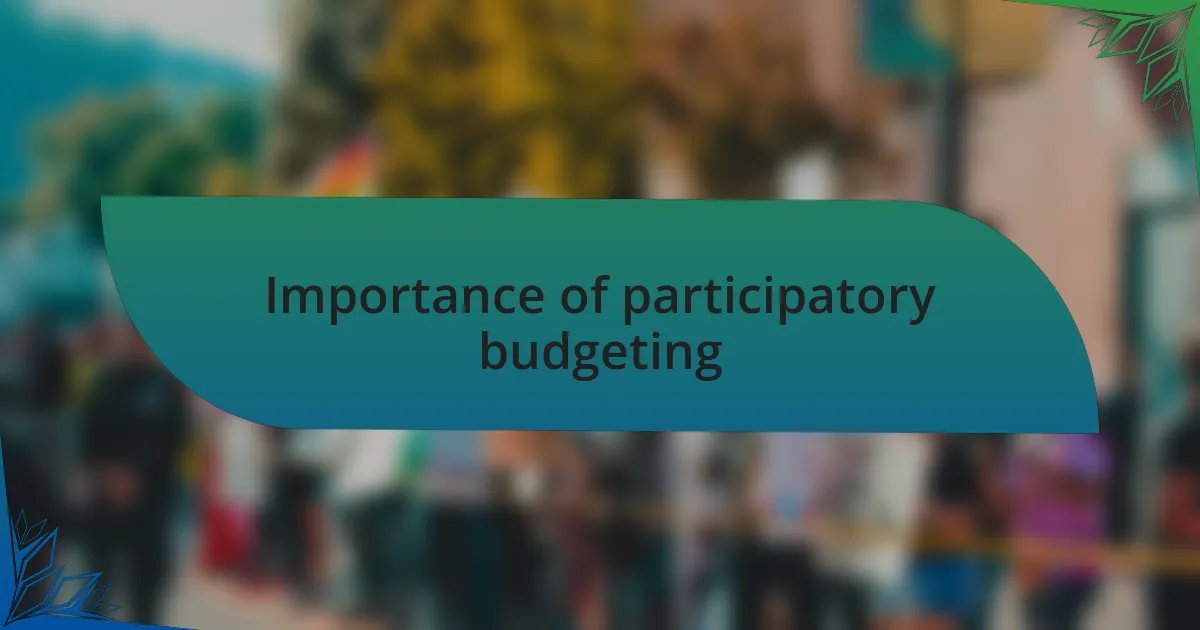
Importance of participatory budgeting
Participatory budgeting is crucial because it democratizes financial decision-making, inviting diverse voices into the conversation. I remember chatting with a friend over coffee, where she mentioned how PB allowed her to advocate for a community garden in a neighborhood that desperately needed green spaces. It made me think: What if more local issues could be vocalized and acted upon through such a platform?
Beyond just involvement, participatory budgeting empowers people by giving them a stake in their community’s future. I once met a young man at a PB session who shared his struggle to find jobs in his area. He proposed a skill-building program funded through PB. This moment struck me as significant; it highlighted how PB not only addresses current needs but also nurtures future generations. Are we truly listening to these innovative solutions when we make budgeting decisions?
Furthermore, the importance of participatory budgeting extends to building trust between citizens and local governments. I recall a particularly heated meeting where residents expressed frustration about past mismanagement of funds. But through PB, they felt a renewed sense of hope. The experience showed me that when people feel their voices are valued, it creates an environment ripe for collaboration and progress. Isn’t that the kind of community we all want to foster?
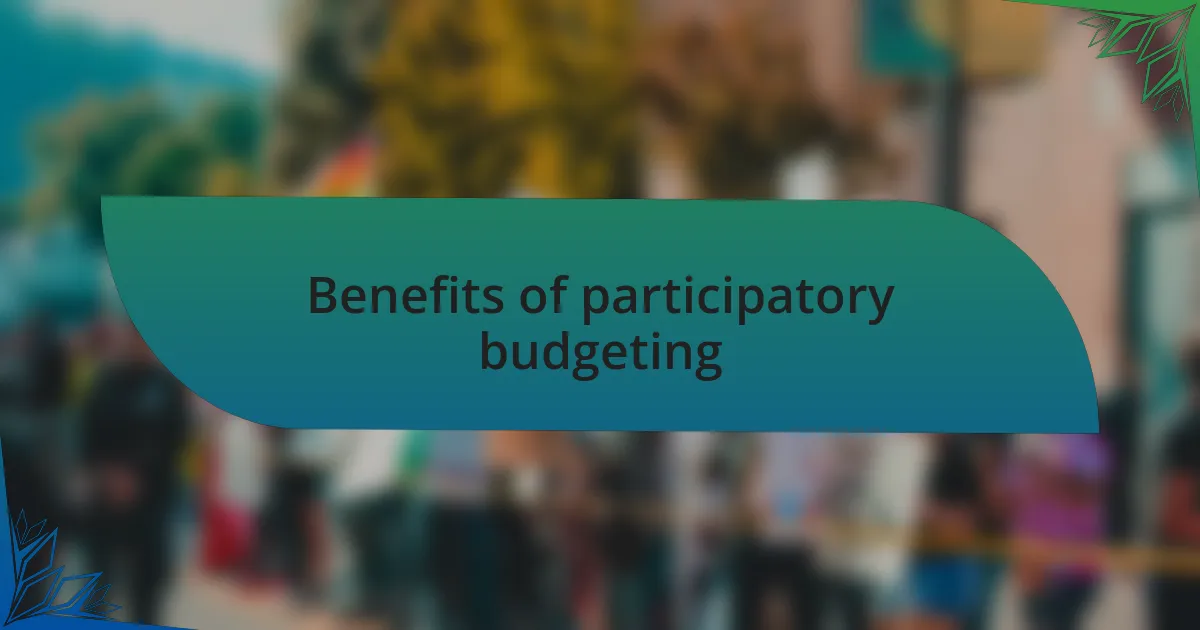
Benefits of participatory budgeting
Participatory budgeting offers a unique opportunity for transparency in local governance. I remember attending a town hall where budget plans were usually shrouded in technical jargon. It was refreshing to see community members dissecting these plans openly, asking questions, and demanding clarity. Isn’t it empowering to know that we can hold our leaders accountable and truly understand how our tax dollars are being spent?
Another notable benefit is the strengthening of community bonds. I once participated in a PB event where neighbors came together, sharing their visions for public spaces. It struck me how these shared goals sparked friendships and collaboration beyond the budgeting process. Can you imagine how much more vibrant our neighborhoods would be if we continued to work together like that?
Additionally, participatory budgeting empowers marginalized voices that are often overlooked. I recall speaking with a woman who had felt voiceless in her community for years. Through PB, she was not only able to contribute her perspective but also lead a project that addressed public safety concerns in her area. How can we ignore the richness of ideas that emerge when everyone is included at the table? The potential for innovative solutions is truly limitless.
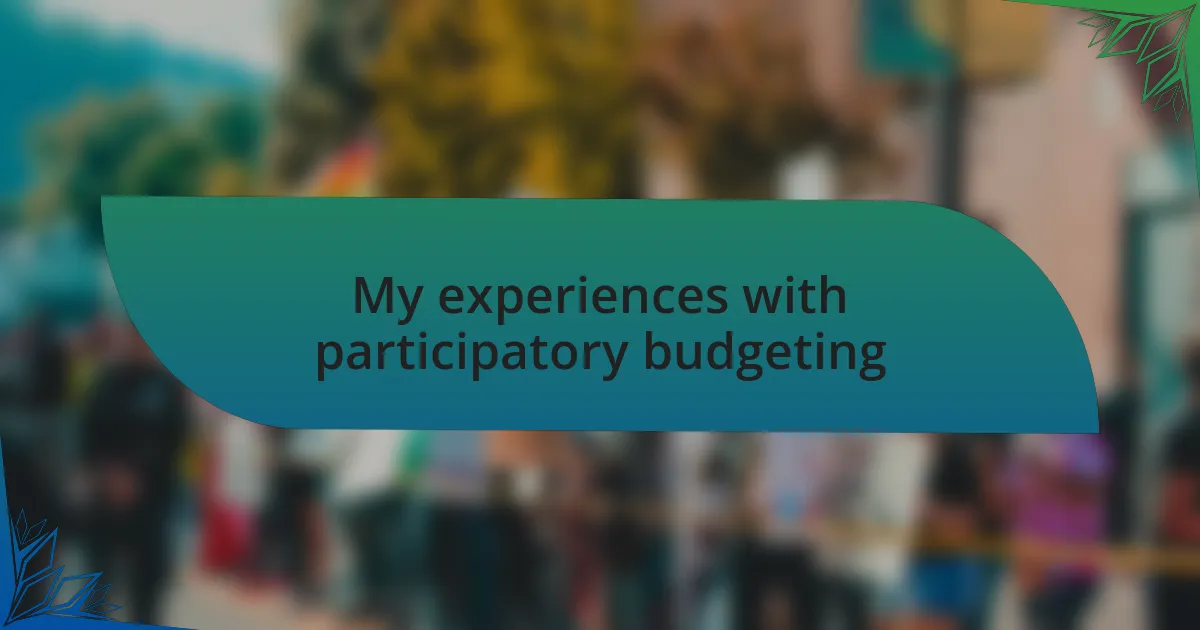
My experiences with participatory budgeting
Participating in a local participatory budgeting session was a transformative experience for me. I vividly remember walking into a community center filled with diverse groups, all animatedly discussing their needs and dreams. It felt electric, witnessing firsthand how collective voices could shape a budget rather than leaving it solely to policymakers. Have you ever been in a room where you genuinely felt your input mattered?
One of the sessions I attended was particularly memorable because we wrestled with tough choices about funding for youth programs versus infrastructure improvements. The passion in the room was palpable; parents advocated for safe places for their kids to play while others pushed for better roads and public transportation. In that moment, I realized that these discussions were not just about numbers; they were about hopes, dreams, and the fabric of our community. It made me ponder—how often do we get to make real decisions about our shared future?
I also noticed how participatory budgeting opened doors for people who usually felt sidelined in political discussions. At one meeting, a retired veteran shared his story about the struggles he faced in accessing community services. As he spoke, I could see the shift in the room—a quiet respect for his experiences. It struck me that PB isn’t just an exercise in allocating funds; it’s a platform for stories that often go untold. How often do we truly listen to those around us? These experiences reaffirmed my belief that participatory budgeting is essential not just for financial decisions, but for cultivating empathy and understanding within our neighborhoods.
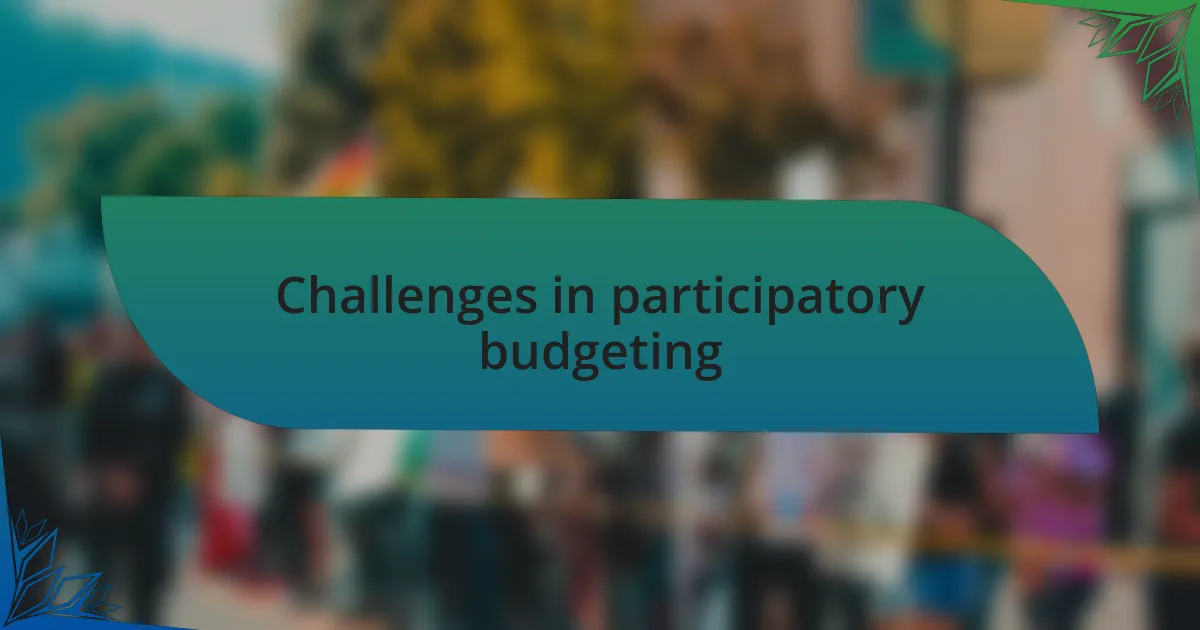
Challenges in participatory budgeting
Participatory budgeting, while promising, can face significant hurdles. One major challenge I’ve observed is the complexity of the budget process itself. When participants confront intricate financial terms and allocation models, it can quickly become overwhelming. Have you ever felt lost in a sea of numbers? I remember sitting there, feeling frustrated when I struggled to keep up with the jargon—terms like “line items” and “funding sources” sometimes feel designed to exclude rather than include.
Another considerable challenge is ensuring diverse community representation. In my experience, not all voices are equally heard. I once noticed a group of younger attendees who had vibrant ideas, yet they didn’t speak up—perhaps intimidated by the older, more vocal participants. It made me wonder: how can we cultivate an environment where everyone feels empowered? Creating a space where varied perspectives flourish requires intentional outreach and support, but that effort can often fall short.
Lastly, addressing conflicting priorities stands as a daunting task. I recall a vote where half the room championed a new library, while the other half was desperate for a community garden. Tensions rose as people passionately defended their causes, creating an atmosphere thick with emotion. This made me think about how critical it is for facilitators to navigate these conflicts delicately, guiding the group toward compromise. How do we move forward when needs seem to clash? Ultimately, it’s about finding common ground and prioritizing what benefits the community as a whole.

Lessons learned from my involvement
Throughout my involvement in participatory budgeting, I’ve learned that patience is crucial. For instance, during one session, I found myself grappling with the urge to rush participants towards a decision. But as I observed the process unfold, I realized that allowing time for discussion enabled deeper understanding and ownership of the budget decisions. Have you ever watched a collective conversation unfold and recognized the power of each voice? It’s a reminder that sometimes, the journey is just as important as the outcome.
I also discovered the significance of clarity in communication. During my early participation, I noticed that using straightforward language can significantly empower attendees. I remember presenting budget options without jargon and seeing the spark of comprehension on people’s faces. It made me realize how transformative it can be when everyone feels aligned with the discussion. How often do we complicate matters when simplicity could bring clarity?
Another key lesson was the importance of fostering relationships. One memorable moment for me was the unexpected connections that formed between participants who initially appeared to have opposing views. After some dialogue, they discovered shared values, which led to collaborative proposals. This experience reinforced my belief that participatory budgeting isn’t solely about the finances—it’s about building a community. Have you considered how relationships shape public decision-making? The bonds we create can truly change the trajectory of our collective goals.
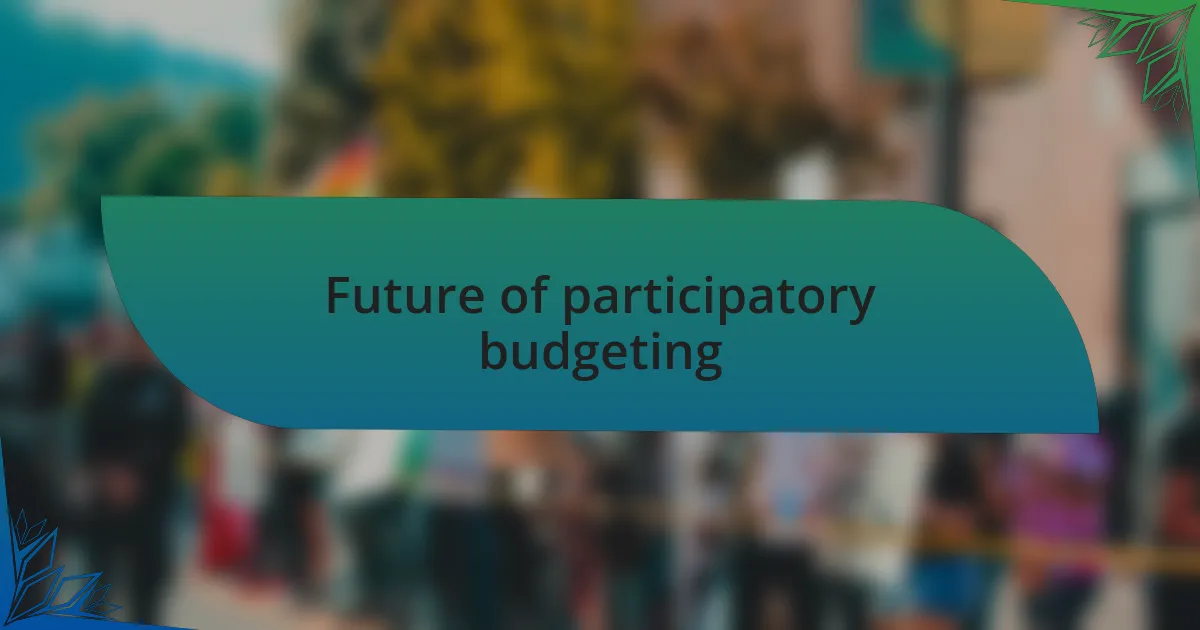
Future of participatory budgeting
The future of participatory budgeting holds significant promise, especially as communities increasingly seek ways to ensure that every voice is heard. I recall a recent meeting where tech-savvy youth proposed digital platforms for submitting ideas and voting, transforming how we engage in the process. Isn’t it exciting to imagine how technology could enhance inclusivity and streamline participation for those who may not attend in-person sessions?
As I reflect on different cities worldwide adopting these processes, I see a trend forming around more diverse engagement methods. When I witnessed a local community organizing a successful outreach campaign targeting underrepresented groups, it made me think about the potential for real change. How can we leverage these innovative approaches to ensure that future budgets truly reflect the needs of all community members?
I also sense a growing movement towards accountability and transparency, stemming from public demand. In conversations with fellow participants, many expressed a desire to track funding more effectively. Could we be on the brink of developing systems that not only promote participation but also hold decision-makers accountable? With such interest, it’s clear that the evolution of participatory budgeting could reshape not just how we allocate funds, but how we view civic engagement altogether.